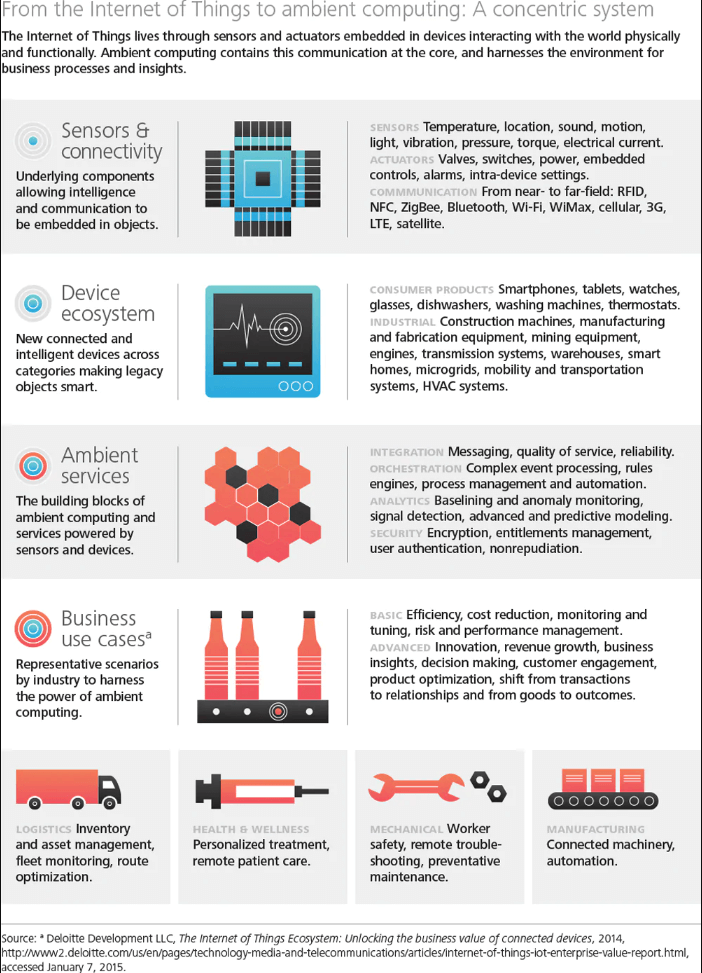If you’ve ever used a motion sensor door, you have a little bit of an idea what ambient computing is. If your car unlocks when you walk towards it with the key fob in your pocket, you’re approaching what ambient computing will look like.
Though neither of these examples involves any computing, they are illustrative of the way ambient computing wants you to interact with the world. Ambient computing aims to change the way we interact with technology.
Most of our devices are named after what we do with them or where we use them. Think of a desktop computer, earbuds, headphones, laptops, smartphones … you name it.
Ambient computing isn’t about where you use technology. It’s about technology you don’t have to “use.” To better understand what that means we need to take a bit of a step back into the history of the technology we use on a daily basis.
The Roots of Computing
Computing started as an expensive venture that only large institutions could afford. ENIAC, generally agreed to be the first digital computer, was massive, clunky and primitive. It was powered by over 20,000 vacuum tubes and cost the equivalent of over $7 million in today’s dollars.
Though mainframes grew smaller and more manageable as time went on, computing was still largely the province of organizations and those with means. And most importantly, it was difficult to use. Even through the 1980s there were systems that accepted input via punch cards.
The first personal computer, the Altair, had to be programmed one bit at a time through the front toggle switches. It came with no monitor and no keyboard. The humble toggle switch was the first input device used for personal computing.
Keyboards came next. ENIAC and its descendants had included keyboards as part of their design, and the keyboard became the standard input device for computers all the way through the 80s into the early 90s.
All the way through the final stages of MS-DOS, users had to memorize a list of commands and make sense of unintuitive interfaces to be able to interact with their system. The mouse slowly gained acceptance through the 1970s and really came into its own with Windows 3.1 and Macintosh OS.
And from that point forward, these devices were the primary method people used to interact with their devices. Keyboards have been used for over eighty years. Mice have been used for forty. Other methods of interacting with devices were primitive at best or relegated to people with disabilities.
If you ever tried to use speech recognition software in the 1990s or even the early 2000s, you were in for a fun time. Even the market leading software would mishear words on a scale that makes the worst of today’s autocorrect failures look like genius.
It’s hard to explain to someone who grew up with smartphones just how revolutionary it is to be able to talk to a device and have it do what you want it to do. And the people behind ambient computing want to take it even further.
Technology That Adapts to You
Think about it — the entire history of personal computing to this point has been us adapting to the way technology is designed to be used.
Sure, we may not be flipping switches on the front panel of an Altair 8800 any more — and indeed, any serious hobbyist bought a keyboard as soon as possible. But we’re still learning how to use our technology the way it’s meant to be used.
What if you didn’t have to use a mouse to point to things on a screen? What if you could just … think it? Or say it? We’re approaching that point with our smart devices.
Actually, forget the screen completely. What if you didn’t have to sit down at your computer? Or pull out your iPad? Or turn on your smartphone? What if technology was just … everywhere around you?
That’s what ambient computing is.
At its most basic, ambient computing isn’t a set of protocols like the Internet or wireless networking. It’s the philosophy that computing shouldn’t be intrusive or invasive. And you’re seeing it more and more around you.
The Internet of Things is the main driver for this. You may have a smart speaker in your home like an Amazon Alexa or an Echo Dot. Instead of you pulling out your smartphone to turn on music, you say, “Alexa, play this song.” Or, “OK Google, can you turn my thermostat down?”
In fact, if you have a smart thermostat, it learns over time what you do with it, slowly adjusting to your patterns and the temperature of the world around you until you don’t even notice or have to adjust it any more. In theory. It’s the closest to what ambient computing is aiming for.
It wants to be completely unobtrusive.
An Electronic World
Ambient computing wants to build you a home that can think for itself. Technology should be as ubiquitous as running water or electricity, and you should have to think about it just as much as you have to think about getting a glass of water from the sink.
Smart speakers and smart thermostats may be the vanguard of ambient computing, but advocates have a bigger vision. “Your devices and services work together,” said Google head of hardware Rick Osterloh at their 2019 annual hardware event. “And it’s fluid so it disappears into the background.”
Osterloh isn’t the only one pushing this philosophy. Google, Samsung, Apple and all the major technology firms are jumping in. Perhaps the most surprising is Google, given that they don’t have much presence in hardware. But for them it’s about integrating their services into as much of your life as possible.
In this vision of the future, your home would learn over time what you do and what happens in your environment and adjust automatically. Your washer would automatically sense the type and volume of clothes you’ve thrown in and adjust automatically to the correct cycle, for instance.
Or when you moved from one room to another the lights would adjust. Or when you get home the front door unlocks as you walk up. The temperature would have been allowed to adjust during the day so that you save money, but would have the house back up to your desired mark by the time you make it home.
With AI and the increasing integration of smart devices into our lives, this world isn’t just science fiction any more. It’s getting close to reality.
It’s Almost Here …
Samsung’s proof of concept at the 2018 CES in Las Vegas is one of the best examples we have of how close this can be.
Samsung designed its exhibit around its Bixby intelligent assistant, using different hardware devices to integrate all of the devices in the home together and automatically adjust without effort from the user.
People could migrate the TV show they were watching from one room to another with a simple voice command. Bixby helped them figure out which show they wanted to watch.
The refrigerator offered suggestions for recipes based on what products were in the fridge and kept track of which items were about to expire. A load of laundry could be put on and automatically adjusted, then started by talking to the TV. Then Bixby would notify when the load was done.
And almost all of this technology is commercially available right now.
The next step for companies like Samsung, Google, Apple, Amazon and other players in this space will be to make listening devices smaller so they can be spread throughout the house more effectively. At the moment ambient computing is dependent on single larger devices like smart speakers. That leads to dead spots in rooms, and if you don’t have a smart speaker everywhere you don’t always have access to it.
Eventually the goal is that you can say something to your digital assistant from anywhere in the house and get feedback audibly and possibly visually. And not just in your house. With your smart devices anything you take with you will cross seamlessly from your home to your car to your phone.
It can be hard to learn how to use technology. Setting up devices is far easier than it used to be. It’s MUCH easier than it was in the days of the Altair 8800, or the IBM PC, or the Apple Macintosh, or even the first iPod. But the next step is making it entirely frictionless. Your world will eventually be seamlessly integrated with ambient computing.
It’s coming. And it’s coming soon.
Are you ready?
Smart devices and the Internet of Things are already here, and if you’re using any of these devices in your home you’re already interacting with ambient computing. It’s just not in its fully realized form yet. If you need a hand understanding technology or any specific help setting up your devices, reach out to HelpCloud Technicians for remote support.
We’ll make sure you get on the right track.


